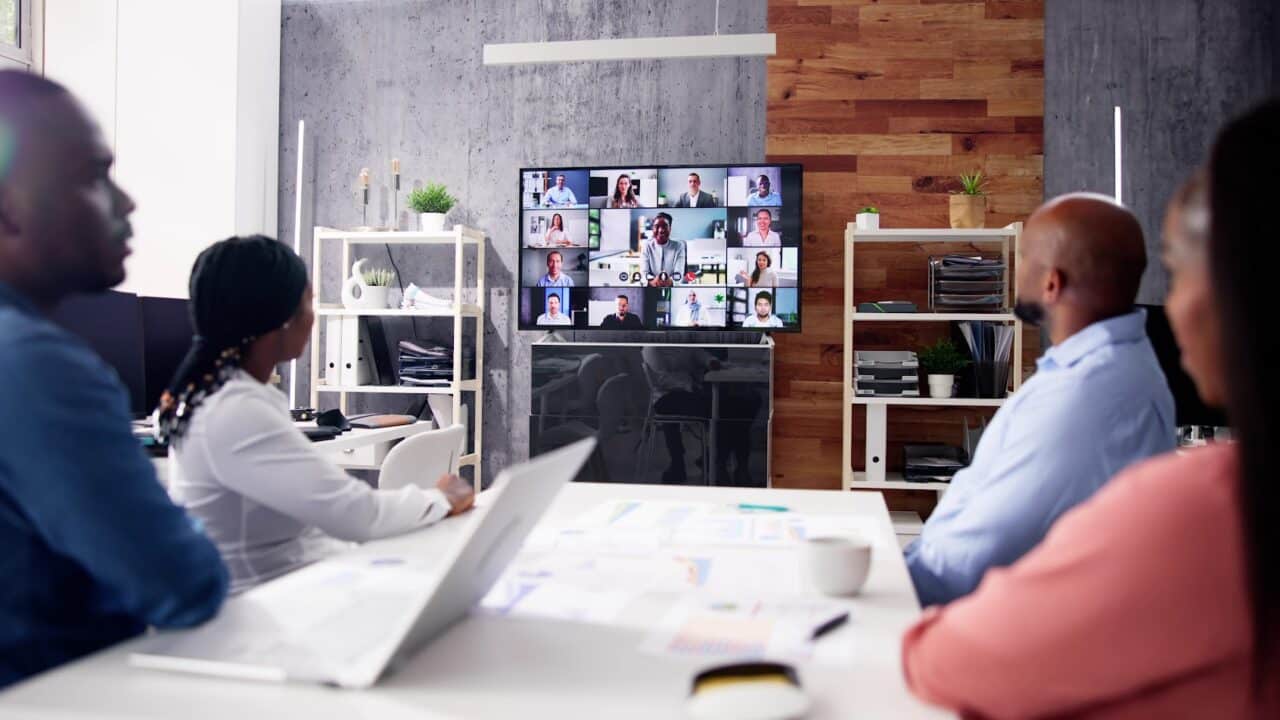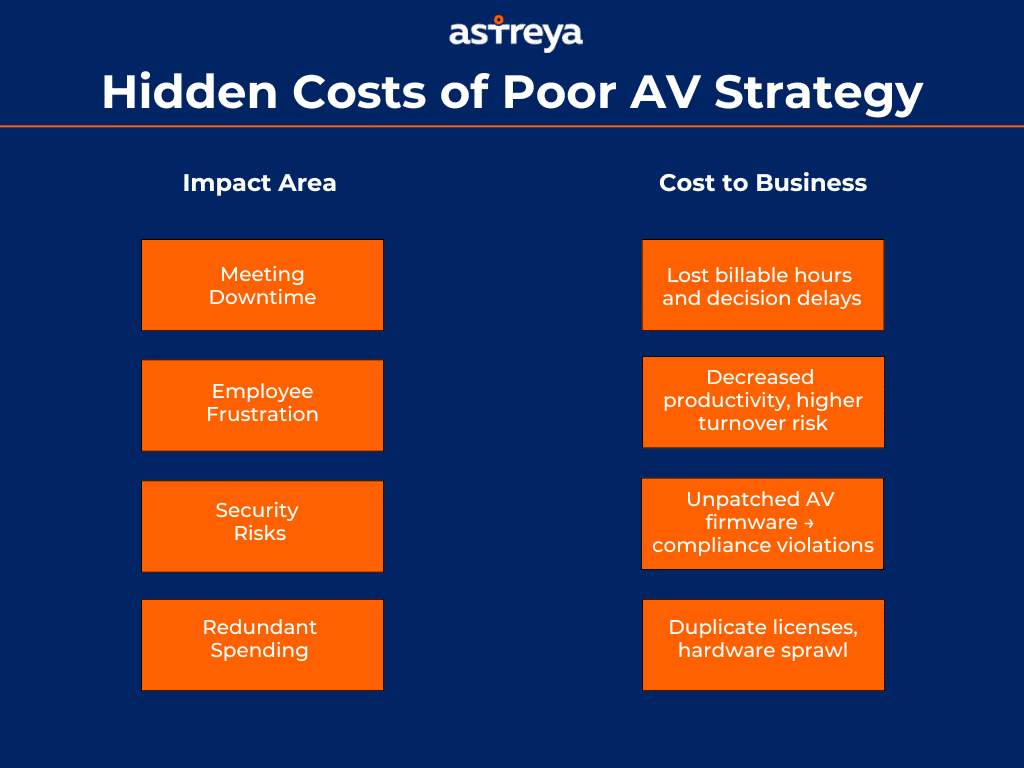
Success in hybrid work environments isn’t about flashy gear or gigabit pipes, it’s about AV-IT unity. When audio-visual and network teams share data and workflows, meetings start on time and tech headaches disappear.
Why AV-IT Integration Drives Hybrid Collaboration
Historically, AV (audio visual) and IT groups have operated in parallel universes. AV engineers chase perfect camera angles, echo-free acoustics, and intuitive room controls.
IT leaders obsess over network throughput, security patches, and compliance frameworks. When these teams don’t speak the same language or manage support through different ticketing systems issues fall through the cracks.
Real-World Situation: Monday, 9 a.m. The CFO calls in from New York, the marketing team from London, a mic won’t unmute, and 10 minutes evaporate. AV and IT integration isn’t just a nice-to-have anymore, it’s a prerequisite for smooth and productive hybrid collaboration.
Companies must establish shared ownership, joint roadmaps, and unified support channels to achieve true AV-IT alignment. That means integrating AV workflows directly into ITSM (IT Service Management) platforms, consolidating dashboards, and cross-training staff to view every meeting room as a network endpoint.
Key Challenges Creating that Create the AV and IT Gap
When AV and IT aren’t synchronized, the impact ripples across productivity, budgets, and even company morale. The hidden costs of poor AV-IT alignment are high:
Siloed teams and tools: AV and IT often use separate systems and processes, making it hard to coordinate on meeting support.
Slow issue resolution: Meeting room glitches take longer to fix when support tickets bounce between disparate teams.
Inconsistent experiences: Without a unified strategy, remote and in-room participants suffer from poor audio/video quality and connectivity issues. Over 8 in 10 workers globally say they lose meeting time due to technical difficulties during online and hybrid meetings.
Downtime & Delays: A single malfunctioning microphone or frozen video feed can derail an entire meeting, leading to decision delays and frustrated executives.
Employee Frustration: Hybrid workers cite AV glitches as their top complaint, and frequent disruptions can erode confidence in corporate technology.
Hidden Security Risks: Outdated AV firmware often escapes routine IT patch cycles, opening backdoors for potential breaches.
According to the Gartner 2024 Digital Worker Survey, 42% of respondents said they prefer to join a meeting from the meeting room system.
It’s no surprise, then, that even with big investments in new tech, hybrid meetings can still disappoint. Gartner’s 2024 Digital Worker Survey found that 65% of respondents said their organizations upgraded their meeting room technology, yet hybrid remains employees’ least preferred way to meet because of ongoing tech problems.
Hidden Costs of AV and IT Silos

By tackling these challenges head-on, businesses can reclaim lost hours, tighten security, and improve spending.
Curious how top firms eliminate these costs?
Watch Our On-Demand Webinar: The Future of IT Service Management
Where Astreya’s experts Josh Spring (Practice Lead, Service Desk), Khanh Ngo (Practice Lead, ITAM & Supply Chain), and Jay Moreno (IT Operations Specialist) explore how AI and automation are reshaping IT support.
Top Benefits of AV and IT Alignment in Meeting Rooms
You must ensure that your audio and visual (AV) systems work together to get the most out of your business. And when they complement each other, here’s what you can expect:
1. Friction-Free Meeting Startups
When AV devices and IT networks operate as one, meetings start on time and stay that way. Automated device health checks, pre-meeting diagnostics, and real-time alerts mean participants focus on content, not cables.
2. Single-Pane Insights for Room & Network Health
Imagine a single pane of glass that displays room usage, camera status, network latency, and microphone levels. Integrated analytics empower teams to spot trends like underused huddle spaces or frequent hardware faults and strategically plan upgrades.
Astreya Spotlight:
As a trusted partner in AV design and IT infrastructure, Astreya offers turnkey workplace collaboration solutions, combining AV systems in enterprise IT with advanced ITSM integration.
3. AV Helpdesk Automation with Unified Ticketing Tools
Merging AV support into the IT Help Desk streamlines problem resolution. For example, integrating AV incident reporting into an IT service management platform (like ServiceNow) means all conference room issues go into the same ticket queue as other IT issues. No more confusion over who owns a problem one unified support team can tackle it immediately.
4. Maximum ROI on AV Budgets
Predictive maintenance and lifecycle management extend the usable life of AV equipment. By consolidating vendor contracts and leveraging standardized platforms, such as Logitech Rally with Cisco WebEx or Crestron with Zoom, businesses avoid costly upgrades and license overlaps.
Astreya’s Framework for Enterprise AV-IT Integration
As a leader in enterprise collaboration, Astreya marries deep AV design expertise with robust IT infrastructure services. Our approach includes:
Comprehensive Technology Audits: We map every projector, codec, and switch on your network — identifying single points of failure and optimization opportunities.
Vendor Standardization: Reduce sprawl by selecting end-to-end solutions tailored to your workflows (Logitech + Zoom, Cisco WebEx + Crestron, etc.).
Cross-Training Programs: Our certified specialists run joint workshops, ensuring your AV and IT teams share knowledge on network security, firmware management, and room automation.
Smartsheet-driven Rollouts: Track every project milestone, from pilot installations to enterprise-wide deployments, with real-time dashboards and automated progress reports
6-Step Roadmap to Implement AV-IT Integration
- Launch a Joint Audit: Gather AV and IT stakeholders to inventory devices, firmware versions, and network dependencies.
- Define Shared KPIs: Agree on metrics like mean time to resolution (MTTR), meeting success rate, and user satisfaction scores.
- Consolidate Platforms: Standardize on a unified stack, minimizing device diversity and streamlining firmware management.
- Automate Workflows: Embed AV incident creation, assignment, and escalation into your existing ITSM platform.
- Enable Proactive Support: Deploy AI-driven diagnostics to flag hardware degradation before meetings start.
- Monitor & Optimize: Use integrated dashboards to review performance monthly and iterate on improvements.
Why Enterprises Choose Astreya for AV-IT Modernization
We give you everything you need for a smart and simple AV-IT setup, including expert help, fast installation, and full support.
When AV and IT work together, your hybrid workplace runs smoother. You’ll get more reliable meetings, better security, and stronger ROI.
Ready to elevate your collaboration strategy? Contact Astreya today and experience the power of AV-IT alignment.
FAQ: AV-IT Integration
What is AV and IT integration?
AV and IT integration refers to the alignment of audiovisual systems (projectors, microphones, video conferencing) with an organization’s IT infrastructure to enhance collaboration, performance, and support.
Why is AV and IT alignment important?
Without alignment, meetings fail, support is fragmented, and costs rise. Integration ensures efficiency, improved user experience, and reduced downtime.
What are common challenges when AV and IT aren’t aligned?
- Poor audio/video quality
- Disparate support tickets
- Redundant hardware purchases
- Limited visibility into device and network health
How can businesses improve AV and IT collaboration?
Start with joint planning, vendor standardization, integrated support workflows (ServiceNow), and deploy AI-based diagnostics and centralized NOC control.
Does Astreya provide integrated AV and IT solutions?
Yes. Astreya specializes in workplace collaboration and AV modernization with deep IT integration expertise, covering Logitech, Zoom, ServiceNow, Cisco, and more.